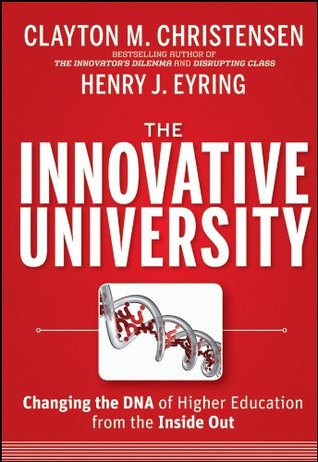More on this book
Kindle Notes & Highlights
Read between
May 28, 2016 - December 23, 2017
Seen through the lens of disruptive innovation theory, universities are at a critical crossroad. They are both at great risk of competitive disruption and potentially poised for an innovation-fueled renaissance.
For-profit universities and technical institutes, though expensive relative to public institutions and in some cases of dubious quality, are more convenient and more attuned to students' needs, especially the need for marketable skills.
the typical university must change more quickly and more fundamentally than it has been doing.
For the first time since the introduction of the printed textbook, there is a new, much less expensive technology for educating students: online learning.
The combination of disruptive technology and increased focus on educational outcomes opens the door to new forms of competition, particularly from the private sector.
Disruptive innovation is thus initially a boon to nonconsumers of a product or
the standard model has become unsustainable.
Harvard incurs tremendous costs in achieving such wide-ranging excellence; its annual operating budget approaches $4 billion.14
As we'll see in Part III, Ripe for Disruption, the Harvard model, which was not fully understood by the many institutions that have copied it, is now unsustainable for all but a few.
The McKinsey team began by quantifying the average cost incurred by all institutions to produce one associate's or bachelor's degree: $56,289 and $74,268, respectively.16
They must become much more affordable, particularly by embracing online learning technology.
During its drafting, the Spellings Commission report had been described by one of its own members as “flawed” and “hostile.”2
Despite the favorable opinions of undergraduates and alumni, a closer look at the record…shows that colleges and universities, for all the benefits they bring, accomplish far less for their students than they should.
The University of Phoenix, for example, recognized revenues of $2.5 billion in 2007; by the end of 2009 that figure had risen to nearly $3.8 billion.13 In that year it enrolled 355,800 new students, roughly 150,000 more than the total enrollment of the ten campuses of the University of California.14
A trimester system allows bachelor's degree-seekers to graduate in three calendar years.
Quality is monitored through rigorous learning outcomes measurement and via a “Net Promoter Score,
many young college students still seek the assurance of traditional university names and the benefits of campus life.
The strategy of most schools is one of imitation, not innovation.20
In setting tuition levels, the primary question is not what students are willing and able to pay. Thanks to government grants and loans, the students are less price sensitive in their higher education choices than in other purchase decisions.
Most established organizations, including for-profit companies, readily adopt new technologies that show potential for enhancing their size and standing. However, they are much less likely to see the value of innovations that would reduce the price a customer pays,
new entrants to an industry typically begin at the bottom of a market, selling simple, affordable products to easily satisfied consumers,
Toyota had decades to improve its subcompacts to the point that they were recognized as something better than just the cheapest car on the market.
BYU-Idaho has adopted a unique definition of bigger and better.
BYU-Idaho's creators made unusual decisions about the three choices that determine the productive capacity of a university community: which students it serves, what subject matter it emphasizes, and what types of scholarship it pursues.
among BYU-Idaho's most watched statistics is the percentage of students admitted, rather than the percentage denied.
success in an increasingly competitive higher education environment requires each institution to identify and pursue those things it can do uniquely well.
Beginning in 1767, tutors specialized by subject rather than spanning the entire curriculum.17
“I am not aware that any one single thing is well taught to the Undergraduates of Harvard College.”23


